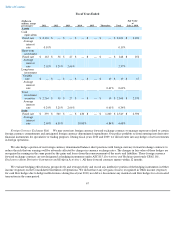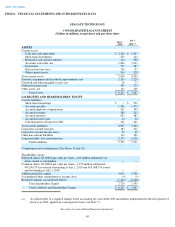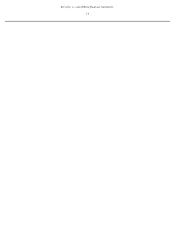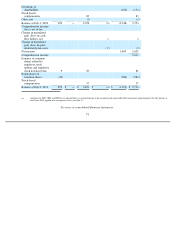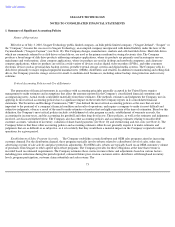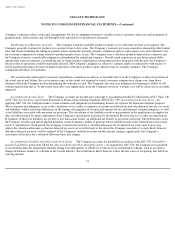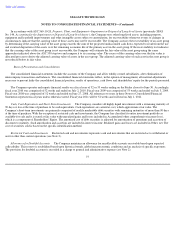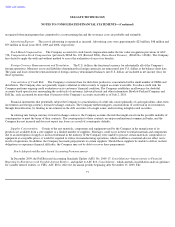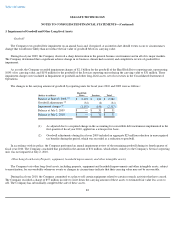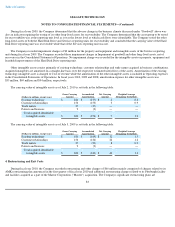Seagate 2009 Annual Report Download - page 79
Download and view the complete annual report
Please find page 79 of the 2009 Seagate annual report below. You can navigate through the pages in the report by either clicking on the pages listed below, or by using the keyword search tool below to find specific information within the annual report.
Table of Contents
SEAGATE TECHNOLOGY
NOTES TO CONSOLIDATED FINANCIAL STATEMENTS—(Continued)
Company's estimates reflect contractual arrangements but also its judgment relating to variables such as customer claim rates and attainment of
program goals, and inventory and sell-through levels reported by its distribution customers.
Establishment of Warranty Accruals. The Company estimates probable product warranty costs at the time revenue is recognized. The
Company generally warrants its products for a period of one to five years. The Company's warranty provision considers estimated product failure
rates and trends (including the timing of product returns during the warranty periods), estimated repair or replacement costs and estimated costs
for customer compensatory claims related to product quality issues, if any. The Company uses a statistical model to help with its estimates and
the Company exercises considerable judgment in determining the underlying estimates. Should actual experience in any future period differ
significantly from its estimates, or should the rate of future product technological advancements fail to keep pace with the past, the Company's
future results of operations could be materially affected. The Company's judgment is subject to a greater degree of subjectivity with respect to
newly introduced products because of limited experience with those products upon which to base its warranty estimates. The Company
continually introduces new products.
The actual results with regard to warranty expenditures could have an adverse or favorable effect on the Company's results of operations if
the actual rate of unit failure, the cost to repair a unit, or the actual cost required to satisfy customer compensatory claims vary from those
estimates which the Company used in determining the warranty accrual. The Company also exercises judgment in estimating its ability to sell
certain repaired disk drives. To the extent such sales vary significantly from the Company's forecast, warranty cost will be adversely or favorably
impacted.
Accounting for Income Taxes. The Company accounts for income taxes pursuant to Accounting Standards Codification (ASC) Topic 740
(ASC 740), Income Taxes (previously Statement of Financial Accounting Standards (SFAS) No. 109, Accounting for Income Taxes ). In
applying ASC 740, the Company makes certain estimates and judgments in determining income tax expense for financial statement purposes.
These estimates and judgments occur in the calculation of tax credits, recognition of income and deductions and calculation of specific tax assets
and liabilities, which arise from differences in the timing of recognition of revenue and expense for tax and financial statement purposes, as well
as tax liabilities associated with uncertain tax positions. The calculation of tax liabilities involves uncertainties in the application of complex tax
rules and the potential for future adjustment of the Company's uncertain tax positions by the Internal Revenue Service or other tax jurisdictions.
If estimates of these tax liabilities are greater or less than actual results, an additional tax benefit or provision will result. The deferred tax assets
the Company records each period depend primarily on the Company's ability to generate future taxable income in the United States and certain
non-U.S. jurisdictions. Each period, the Company evaluates the need for a valuation allowance for its deferred tax assets and, if necessary,
adjusts the valuation allowance so that net deferred tax assets are recorded only to the extent the Company concludes it is more likely than not
that these deferred tax assets will be realized. If the Company's outlook for future taxable income changes significantly, the Company's
assessment of the need for a valuation allowance may also change.
Accounting for Goodwill and Other Long-lived Assets. The Company accounts for goodwill in accordance with ASC 350, Intangibles—
Goodwill and Other (previously SFAS No. 142, Goodwill and Other Intangible Assets ). As required by ASC 350, the Company tests goodwill
of its reporting units for impairment annually during its fourth quarter or whenever events occur or circumstances change, such as an adverse
change in business climate or a decline in the overall industry, that would more likely than not reduce the fair value of a reporting unit below its
carrying amount.
74


